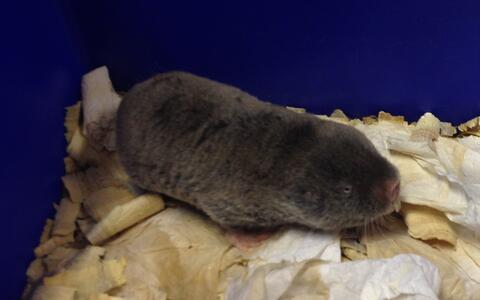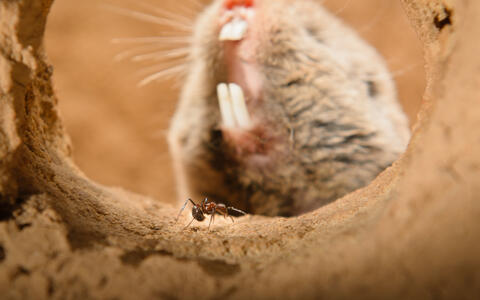Pain free, thanks to evolution
Gary Lewin
Around ten years ago, naked mole-rats at the Max Delbrück Center for Molecular Medicine (MDC) became famous almost overnight. That was thanks to the work of Gary Lewin from Berlin and Thomas Park from Chicago who together investigated the strange sensory world of the naked mole-rat. Park and Lewin showed that these African burrowing rodents were remarkably resistant to pain. In a 2008 article in the journal PLOS Biology, they reported that the mole-rats felt no pain when exposed to acid or capsaicin – the substance that gives chili peppers their heat. The experiments on the mole-rats drew global attention.
For this latest study, just published in Science, Lewin teamed up with colleagues in South Africa and Tanzania to further test more instances of pain insensitivity. “The insights provided by our studies of these animals should help, among other things, in the development of new pain-relieving drugs,” says Lewin, who leads the Molecular Physiology of Somatic Sensation group at the MDC.
Working closely with a world expert on mole-rat biology, Nigel Bennett at the University of Pretoria in South Africa, Gary Lewin, Thomas Park and colleagues explored how naked mole-rats and eight other related species respond to three substances that usually cause a brief burning sensation on the skin of humans and other mammals. Those substances were: diluted hydrochloric acid, capsaicin, and allyl isothiocyanate (AITC). AITC is what gives wasabi, the popular condiment served with sushi, it’s extremely hot taste. The idea was that mole-rats are naturally exposed to these and similar substances in the wild.
Only the highveld mole-rat is impervious to wasabi’s sting
Highveld Mole Rat
In the Science article, whose lead authors are Ole Eigenbrod and Karlien Debus, the scientists report that three mole-rat species proved to be insensitive to the acid. Interestingly, those three species are not particularly closely related through evolution. Two species did not show evidence of pain after having a capsaicin solution injected into their paw. “Others briefly lifted their paw, or licked at it, which shows us that those animals did feel a brief sensation of pain,” explains Lewin.
Only a single mole-rat species proved to be impervious to AITC. This was not the naked mole-rat, but another burrowing rodent called the highveld mole-rat, which is named after the region in eastern South Africa where the animals are exclusively found. “This was a thrilling finding for us,” says Lewin. “AITC attacks amino acids in the body and can thus destroy proteins. That is why all the other species we know avoid coming into contact with the substance.” The highveld mole-rat was the only species in the experiment that had no problem with AITC.
AITC and many other irritants found in roots – one of the mole-rat’s main food sources – activate TRPA1.
It’s all down to altered ion channels
In order to uncover the molecular reasons for the mole-rat’s remarkable resistance to pain, the researchers took sensory tissue from the spinal cord and dorsal root ganglia of all nine species studied. In the dorsal root ganglia there are clusters of neurons that transmit pain signals to the spinal cord. “With the help of state-of-the-art sequencing technology, we were able to compare the activity of around 7,000 genes inside that tissue,” reports Lewin.
Relatively quickly, the team observed that the activity of two genes was altered within the animals that felt no pain. These genes contain the blueprint for the ion channels TRPA1 and NaV1.7. It is already known that these two channels are involved in the perception of pain.
“AITC and many other irritants found in roots – one of the mole-rat’s main food sources – activate TRPA1,” explains Lewin. That is why, over the course of evolution, many species have downregulated the gene for this channel. “But the ‘wasabi channel’ is the only one to be completely switched off in the highveld mole-rat,” Lewin says. He and his team went on to discover that this is due to a particularly active gene for another channel – the constitutively open channel NALCN, known as a “leak channel.” The research group found that the expression of this channel was the only one that was significantly altered in the highveld mole-rat.
Mole-rat pain resistance can be switched off
Lewin was particularly surprised by the results of a further experiment. “When we blocked the NALCN channel by administering a drug that blocks the channel, the highveld mole-rat suddenly became sensitive to AITC after all,” he reports. But just one day after the antagonist had been administered, the animals regained their indifference to the substance. “From the thousands of genes we were looking at, we had obviously found the very gene responsible for the highveld mole-rat’s remarkable pain resistance,” says Lewin with a smile, delighted that luck was so clearly on his side.
Daniel Hart, a PhD student working with Nigel Bennett, discovered that highveld mole-rats often share their burrows with Myrmicaria natalensis, commonly known as the Natal droptail ant. “These insects are known for their aggressive nature and highly pungent venom,” says Lewin. When this ant venom was injected into their paw, all mole-rat species in the study experienced a brief moment of pain – all except the highveld mole-rat. But when the researchers blocked the NALCN channel in the highveld mole-rat, these animals became sensitive to the venom.
New findings could help pharmaceutical research
Lewin surmises that “throughout the course of evolution, the highveld mole-rat has clearly acquired a highly active gene for a single ion channel, which has allowed it to make its home in places that are avoided by other species of mole-rat.” The MDC scientist regards this as another wonderful example of how environment shapes evolution over the long term. “On the more practical side, this discovery could well lead to the development of highly effective analgesics,” he adds. “The highveld mole-rat has showed us that high expression of the NALCN channel seems to be a very effective way of alleviating pain.”
Further information
Original Paper
Ole Eigenbrod, Karlien Debus et al. (2019): „Rapid molecular evolution of pain insensitivity in multiple African rodents“, Science, doi/10.1126/science.aau0236.
- The Max Delbrück Center for Molecular Medicine (MDC)
-
The Max Delbrück Center for Molecular Medicine in the Helmholtz Association (MDC) is one of the world’s leading biomedical research institutions. Max Delbrück, a Berlin native, was a Nobel laureate and one of the founders of molecular biology. At the MDC’s locations in Berlin-Buch and Mitte, researchers from some 60 countries analyze the human system – investigating the biological foundations of life from its most elementary building blocks to systems-wide mechanisms. By understanding what regulates or disrupts the dynamic equilibrium in a cell, an organ, or the entire body, we can prevent diseases, diagnose them earlier, and stop their progression with tailored therapies. Patients should benefit as soon as possible from basic research discoveries. The MDC therefore supports spin-off creation and participates in collaborative networks. It works in close partnership with Charité – Universitätsmedizin Berlin in the jointly run Experimental and Clinical Research Center (ECRC), the Berlin Institute of Health (BIH) at Charité, and the German Center for Cardiovascular Research (DZHK). Founded in 1992, the MDC today employs 1,600 people and is funded 90 percent by the German federal government and 10 percent by the State of Berlin.









